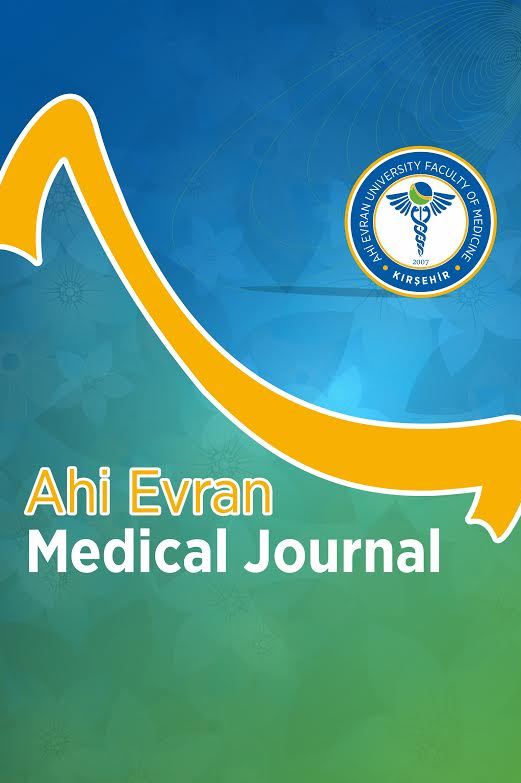Yaşlı Olgularda Cerrahi İlişkili Nöroşirürjikal Komplikasyonlar: Risk Faktörlerinin Tanımlanması ve Preoperatif Değerlendirmenin Önemi
Amaç: 60 yaş üstündeki nöroşirürjikal olgularda karşılaşılabilecek cerrahi komplikasyonların ortaya konması ve literatür eşliğinde tartışılması amaçlanmıştır. Materyal ve Metot: Kliniğimizde nöroşirürjikal operasyon uygulanan 60 yaş üzerindeki 283 olgunun dosyaları taranmıştır. Cerrahi lokalizasyona göre; kranial, spinal ve periferik sinir cerrahisi uygulanan olgular olarak 3 farklı grupta değerlendirilmiştir. Komplikasyonların ortaya çıkma süreci; erken hospitalize, geç hospitalize ve geç dönemde görülen koplikasyonlar olarak 3 grupta değerlendirilmiştir.Bulgular: 117 olguya kranial, 52 olguya spinal, 114 olguya da periferik sinir cerrahisi uygulanmıştır. Uygulanan cerrahi türüne göre karşılaşılan komplikasyonların oranları ortaya konmuştur. Kranial cerrahi uygulanan olgularda erken postoperatif dönemde ve taburculuk sonrası karşılaşılan komplikasyonların sayısı arasında belirgin bir fark bulunmamıştır. En sık karşılaşılan komplikasyon, yara yeri enfeksiyonu olarak tespit edilmiştir. Karnofky skoru düşük olan olgularda, ek nörolojik defisit gelişme sıklığı belirgin yüksek bulunmuştur. Postoperatif iyileşme sürecinin belirgin derecede uzun olduğu görülmüştür. Sonuç: Yaşlı olgularda nöroşirürjikal komplikasyonlardan kaçınmak için ek önlemler gerekebilir. En sık rastlanılan kompliasyonlar yara enfeksiyonlarıdır. Karnofky skoru değerlendirmesi, postopeatif süreçte yaşam kalitesi ve süresinin öngörülmesinde en önemli paramatrelerden biridir.
Anahtar Kelimeler:
nöroşirürjikal komplikasyonlar, yaşlı olgularda komplikasyonlar, yara enfeksiyonu, Karnofsky skoru derecelendirmesi, nöroşirürji
Surgery-Related Neurosurgical Complications in Elderly Patients: Definition of Risk Factors and Importance of Preoperative Assessments
Purpose: To reveal the surgical complications that may be encountered in neurosurgical patients over 60 years of age and to discuss them according to literature. Materials and Methods: The files of 283 patients over 60 years of age who underwent neurosurgical operation in our clinic were reviewed. According to surgery type, they were evaluated in 3 different groups as cranial, spinal and peripheral nerve surgery. The stages of the emergence of complications were evaluated in 3 groups: early hospitalization, late hospitalization, and late period complications. Results: 117 patients underwent cranial, 52 patients underwent spinal and 114 patients underwent peripheral nerve surgery. Depending on the applied surgical technique, the rates of complications were determined. In patients who underwent cranial surgery, there was no significant difference between the number of complications encountered in early postoperative and post-discharge periods. Wound site infection was the most common complication. In the patients whose Karnofsky score is low, the incidence of additional neurological deficit development was found to be significantly higher. The postoperative recovery period was found to be prominently longer. Conclusion: Additional methods may need to be used to prevent the development of neurosurgical complications in elderly patients. Among those complications, wound infection is the most common. The Karnofsky score assessment is one of the most important parameters in predicting the quality and length of life in the postoperative period for cranial and spinal surgeries.
Keywords:
neurosurgical complications, elderly patients complications, wound infection, Karnofsky score grading, neurosurgery,
___
- 1 - Crooks, V, Waller S, et al. The use of the Karnofsky Performance Scale in determining outcomes and risk in geriatric outpatients. J Gerontol 1991; 46:M139-M44.
- 2 - Schag CC, Heinrich RL, Ganz PA. Karnofsky performance status revisited: Reliability, validity, and guidelines. J Clin Oncology 1984; 2:187-93.
- 3 - Çakır CÖ ve Çaylı S: Komplikasyonlara Genel Bakış. Türk Nöroşirürji Dergisi 2013; 23:114-20.
- 4 - Applebaum EL, Chow JM. CSF Leaks. In: Cummings CW (ed). Otolaryngology Head and Neck Surgery St Louis Mosby 1993.p.965-74.
- 5 - Cammisa FP Jr, Girardi FP, Sangani PK, Parvataneni HK, Cadag S, Sandhu HS: Incidental durotomy in spine surgery. Spine (Phila Pa 1976) 2000; 25:2663–7.
- 6 - Khan MH, Rihn J, Steele G et al: Postoperative management protocol for incidental dural tears during degenerative lumbar spine surgery: a review of 3,183 consecutive degenerative lumbar cases. Spine (Phila Pa 1976) 2006; 31:2609-13.
- 7 - Epstein NE: The frequency and etiology of intraoperative dural tears in 110 predominantly geriatric patients undergoing multilevel laminectomy with noninstrumented fusions. J Spinal Disord Tech 2007; 20:380–6.
- 8 - Nichols RL, Smith JW, Klein DB.et al. Risk of infection after penetrating abdominal trauma. N Engl J Med 1984; 311:1065-70.
- 9 - Uzunköy A. Cerrahi alan enfeksiyonlarında ameliyathanenin rolü. Harran Üniversitesi Tıp Fakültesi Dergisi 2004; 1:38-48.
- 10 - Bozfakioğlu Y. Cerrahi alan infeksiyonlarında patogenez ve sınıflama. Hastane İnfeksiyonları Dergisi 2001; 5:91-4.
- 11 - Nystrom PO, Jonstam A, Hojer G, Ling L. Incisional infection after colorectal surgery in obese patients. Acta Chir Scand 1987; 153:225-7.
- 12 - Akdag G, Algin DI, Musmul A, Erdinc OO. İntrakraniyal Cerrahi Geçiren Hastalarda Epilepsi: 15 Yıllık Deneyim. Epilepsi 2017; 23:19-24.
- Yayın Aralığı: Yılda 3 Sayı
- Başlangıç: 2017
- Yayıncı: Kırşehir Ahi Evran Üniversitesi
Sayıdaki Diğer Makaleler
İSOTRETİNOİN KULLANAN BİR İNTİHAR GİRİŞİMİ OLGUSU
Yusuf ATAN, Ayşegül İYİLEŞEN DAŞ
Yenidoğan Yoğun bakım Ünitelerinde Palyatif Bakımın Önemi ve Gerekliliği
Şule ÖZEL, Cüneyt TAYMAN, Sabriye KORKUT, Esra Şükran ÇAKAR, Yaprak Engin ÜSTÜN
Meltem HAKKI, Recai DAĞLI, Nazan KOCAOĞLU, Mehmet CANTÜRK, Hakan ATEŞ, Zeynel Abidin ERBESLER
